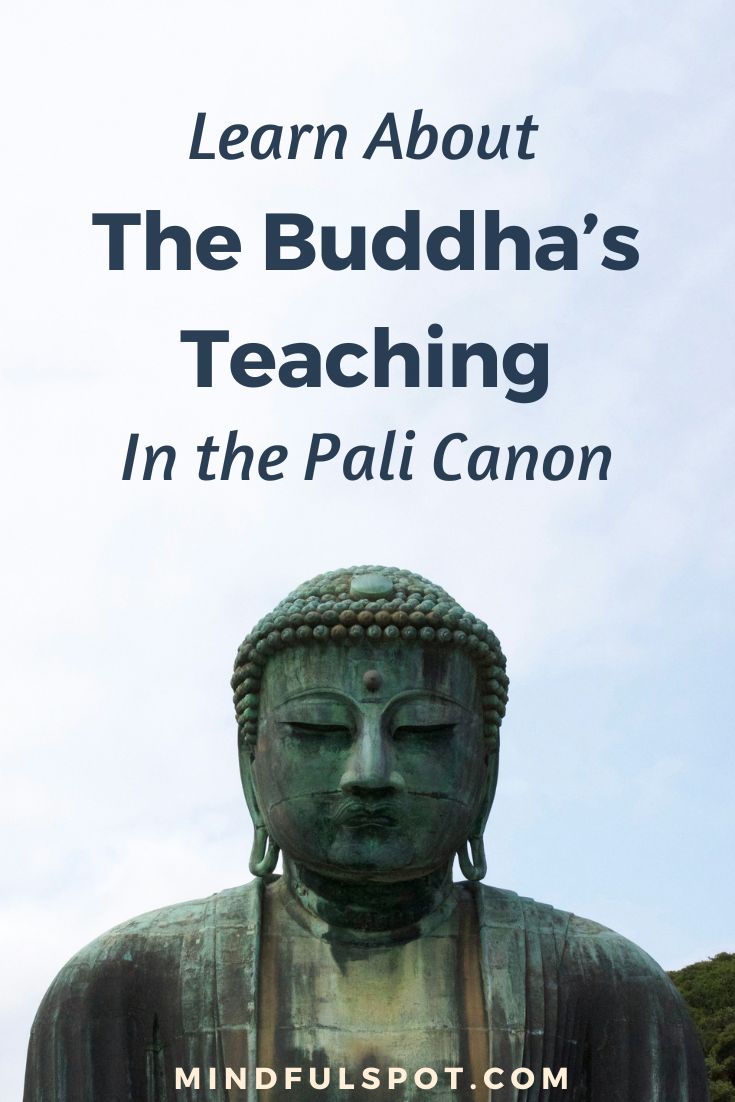You might’ve heard about the “Pali Canon,” also known as the “Three Baskets of Buddhism (Tipitaka).” But what exactly are they? Put simply, the Pali Canon is a collection of ancient sutras containing the Buddha’s teaching.
In ancient times, each mainstream school of Buddhism had its own collection of texts they regarded as the true word of the Buddha. Sadly, most of them were lost when Muslims invaded northern India in the 11th and 12th centuries.
Only one complete collection of texts managed to survive. It belonged to Theravada school, which had been transplanted to Sri Lanka in the third century BCE and escaped the havoc brought upon Buddhism in the motherland.
What Is the Structure of the Pali Canon in Buddhism?
Here’s how the Pali Canon is arranged according to the American scholar-monk Ven. Bhikkhu Bodhi and his book In the Buddha’s Words: An Anthology of Discourses from the Pali Canon:
1. The Vinaya Pitaka, the Compilation of Discipline, which contains the rules laid down for the guidance of the monks and nuns and the regulations prescribed for the harmonious functioning of the monastic order.
2. The Sutta Pitaka, the Compilation of Discourses, which contains the suttas, the discourses of the Buddha and those of his chief disciples as well as inspirational works in verse, verse narratives, and certain works of a commentarial nature.
3. The Abhidhamma Pitaka, the Compilation of Philosophy, a collection of seven treatises which subject the Buddha’s teachings to rigorous philosophical systematization.
Which Collection Should I Study First If I’m a Beginner in Buddhism?
The middle basket, the Sutta Pitaka, is the one you should study if you’re a beginner in Buddhism. It consists of sutras that contain the teachings of the Buddha.
What Is the Best English Translation of Sutta Pitaka?
The best translation of Sutta Pitaka into English consists of these five books:
1. Digha Nikya: The Long Discourses of the Buddha

FREE Self-Test: How Spiritual Are You?
The present work offers a complete translation of the Digha Nikaya, The Long Discourses of the Buddha, the first of the Major collections in the Sutta Pitaka or “Basket of Discourses” belonging to the Pali Canon.
These suttas reveal the penetrating wisdom of the Buddha and include teachings on mindfulness (Mahasatipatthana Sutta); on morality, concentration, and wisdom (Subha Sutta); on dependent origination (Mahanidana Sutta); on the roots and causes of wrong views (Brahmajala Sutta); and a long description of the Buddha’s passing away (Mahaparinibbana Sutta); along with a wealth of practical advice and insight for all those on the Buddhist spiritual path.
The Digha Nikaya is largely governed by the aim of propagating Buddhism within its cultural milieu. Its suttas attempt to establish the supremacy of the Buddha and his Dhamma over their competitors on the Indian religious and social scene.
Thus, the first sutta of DN surveys the philosphical views that the Buddha flatly rejected, the second repudiates the teachings of six contemporary teachers, while many of the following texts pit the Buddha in debate against brahmins and members of other sects; other suttas serve the purpose of glorifying the Buddha and demonstrating his superiority to the gods, the nature spirits, and the ascetics and contemplatives who traveled over the Ganges plain.
—Ven. Bhikkhu Bodhi
2. Majjhima Nikaya: The Middle Length Discourses of the Buddha
The Majjhima Nikaya is the second collection of the Buddha’s discourses found in the Sutta Pitaka of the Pali Canon. Its title means literally the Middle Collection, and it is so called because the sutras it contains are generally of middle length, compared with the longer sutras of the Digha Nikaya, which precedes it, and the shorter sutras making up the two major collections that follow it, the Samyutta Nikaya and the Anguttara Nikaya.
Naturally, the greatest number of discourses in the Majjhima are addressed to the bhikkhus — the monks — since they lived in the closest proximity to the Master and had followed him into homelessness to take upon themselves his complete course of training. …
But in the Majjhima we do not meet the Buddha only in his role as head of the order. Repeatedly we see him engaged in living dialogue with people from the many different strata of ancient Indian society with kings and princes, with brahmins and ascetics, with simple villagers and erudite philosophers, with earnest seekers and vain disputants.
It is perhaps in this scripture above all others that the Buddha emerges in the role ascribed to him in the canonical verse of homage to the Blessed One as “the incomparable leader of persons to be tamed, the teacher of gods and humans.
—Ven. Bhikkhu Bodhi
3. Samyutta Nikaya: The Connected Discourses of the Buddha
The Samyutta Nikaya is the third great collection of the Buddha’s discourses in the Sutta Pitaka of the Pali Canon, the compilation of texts authorized as the Word of the Buddha by the Theravada school of Buddhism.
Within the Sutta Pitaka it follows the Digha Nikaya and Majjhima Nikaya, and precedes the Anguttara Nikaya. The word saṃyutta means literally “yoked together,” yutta being etymologically related to the English “yoked” and saṃ a prefix meaning “together.”
In this collection, sutras are yoked or connected together. And what connects them are the topics that give their titles to the individual chapters, the saṃyuttas under which the sutras fall.
Because SN brings together in its major samyuttas the many abstruse, profound, and delicately nuanced suttas on such weighty topics as dependent origination, the five aggregates, the six sense bases, the factors of the [eightfold] path, and the Four Noble Truths, it would have been perfectly suited for those disciples of intellectual bent who delighted in exploring the deep implications of the Dhamma and in explaining them to their spiritual companions.
The second type of disciples for whom SN seems to have been designed were those monks and nuns who had already fulfilled the preliminary stages of meditative training and were intent on consummating their efforts with the direct realization of the ultimate truth.
Because the suttas in this collection are vitally relevant to meditators bent on arriving at the undeceptive “knowledge of things as they really are,” they could well have formed the main part of a study syllabus compiled for the guidance of insight meditators.
—Ven. Bhikkhu Bodhi.
4. Anguttara Nikaya: The Numerical Discourses of the Buddha
Anguttara Nikaya is the fourth of the four major Nikayas making up the Sutta Pitaka of the Pali Canon, the collection of texts that Theravada Buddhists regard as buddhavacana or “word of the Buddha.”
This work is arranged according to a scheme in which the number of items in the sutras of each successive part increases incrementally over those of the preceding part.
The collection contains eleven nipatas or “books” named simply after their numerical basis: The Ekakanipata, the Book of the Ones; the Dukanipata, the Book of the Twos; and so forth up to the Ekadasakanipata, the Book of the Elevens
Because the short suttas that explain the [Buddhist] philosophical “theory” and the main methods of training found their way into the Majjhima and the Saṃyutta, what remained to be incorporated into the Aṅguttara were short suttas whose primary concern is practical. …
It would be unrealistic, however, to insist that a single criterion has governed the compilation of the Aṅguttara Nikāya, which includes material from the Vinaya, lists of eminent disciples, cosmological ideas, and odd registers of terms that defy easy categorization. What can be said with confidence is that a broad survey of its contents would show a preponderance of texts dealing with Buddhist practice.
Their subjects range from the basic ethical observances recommended to the busy layperson, through the pillars of mind training, to the highest meditative state, the samādhi or concentration of the arahant.
—Ven. Bhikkhu Bodhi
5. In the Buddha’s Words: An Anthology of Discourses from the Pali Canon
In the Buddha’s Words includes selected discourses of the Buddha from the Pali Canon — in modern terminology his “greatest hits” from all the Nikayas mentioned above (and more).
Divided into ten thematic chapters, In the Buddha’s Words reveals the full scope of the Buddha’s discourses, from family life and marriage to renunciation and the path of insight.
This collection allows even readers unacquainted with Buddhism to grasp the significance of the Buddha’s contributions to our world heritage.
Though his teaching is highly systematic, there is no single text that can be ascribed to the Buddha in which he defines the architecture of the Dhamma.
The purpose of the present book is to develop and exemplify such a scheme. I here attempt to provide a comprehensive picture of the Buddha’s teaching that incorporates a wide variety of suttas into an organic structure.
—Ven. Bhikkhu Bodhi
Complement this article with my overview of Theravada Buddhism, and then revisit 5 best Buddhism books for beginners.

FREE mindfulness resources for stress relief
I’m a freelance writer and mindfulness advocate behind this blog. I started my meditation practice in 2014, and in 2017 I launched this website to share what I learn with others. Here are the three things you can do here:
1. Schedule a free consult if you want to learn Buddhist meditation.
2. Download free mindfulness resources for stress relief
3. Join Patreon for exclusive content and community meetings.









